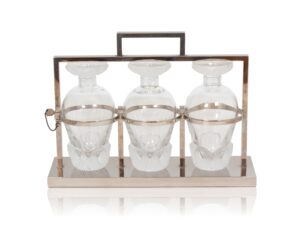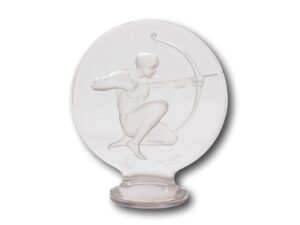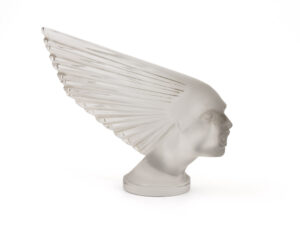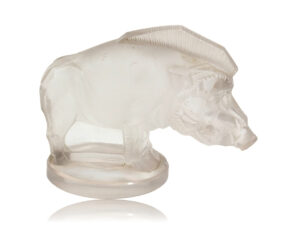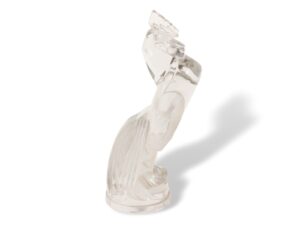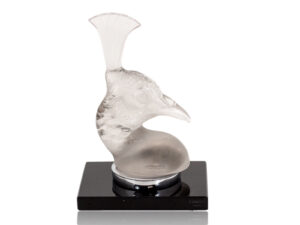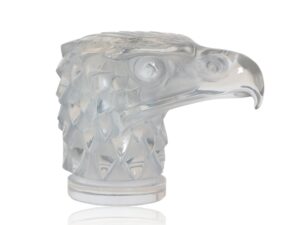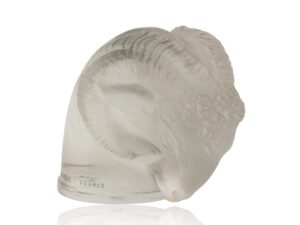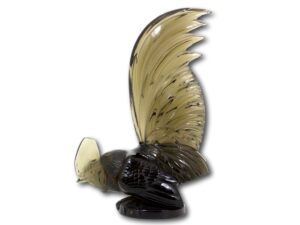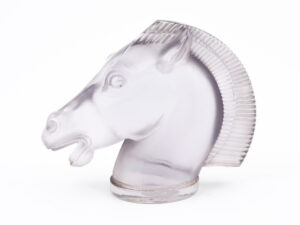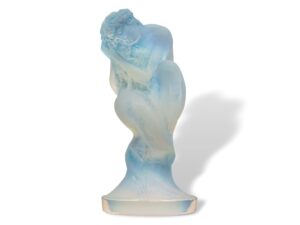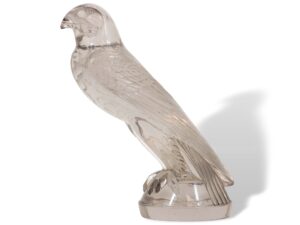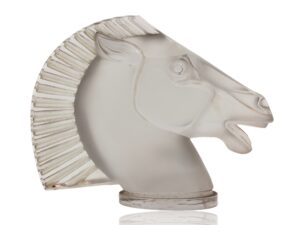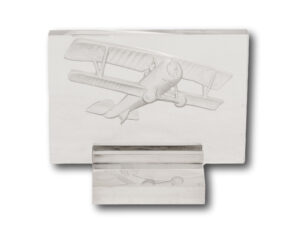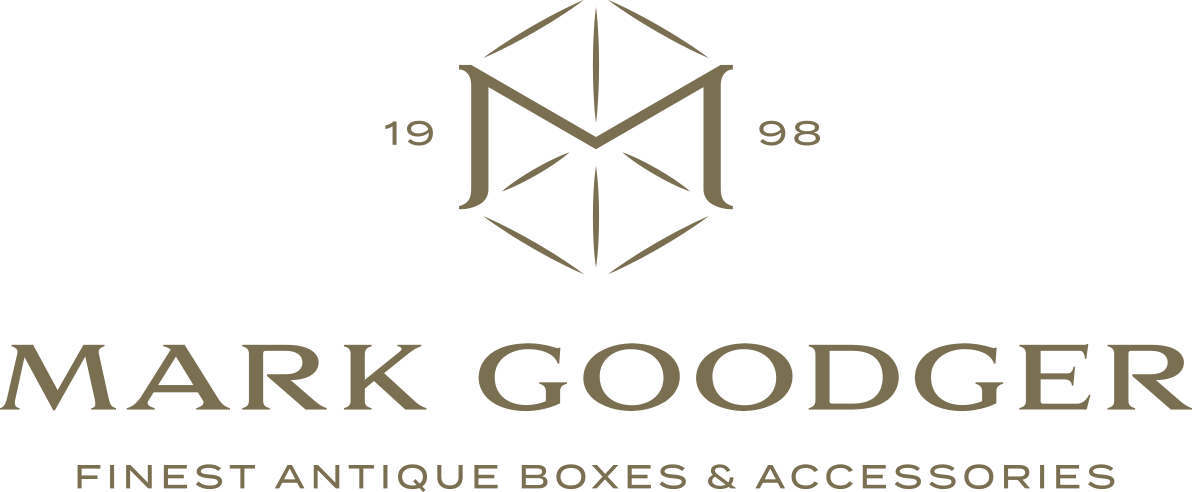Lalique
An established French glass artist and jeweller, René Lalique (1860–1945), made beautiful works of art from glass. He is considered one of the leading Art Nouveau artists and is renowned for the innovative designs he developed and his use of glass in jewellery and decorative objects. The work of Lalique combined traditional jewellery-making techniques with a renewed focus on natural forms, resulting in beautiful and functional pieces.
Between 1925 and 1931, René Lalique created Bouchons de Radiateur – some of his most exquisite car mascot designs. Although their production sadly ceased a year after WWII began in 1940. René owned a factory, Verrerie d’Alsace, in Wingen-sur-Mode, Verrerie d’Alsace. Due to the German occupation of the Alsace region, the factory had to close during the Second World War. He passed away in May 1945, so he did not live to see the end of the war and the reopening of the factory by his son Marc. As a result of his diligent efforts during World War II, steel moulds of the original designs were kept safe; there was no risk to their safety. When it ended, Marc resumed production of the famous mascots designed by his father, using these original moulds. Rather than being sold as mascots for cars, these commemorative paperweights served as desk adornments during the post-war period. In the late 1800s, design and technology (along with motor car production) quickly gathered pace. The invention of the Internal Combustion Engine soon transformed motoring forever. A more reliable and user-friendly engine, the Internal Combustion Engine – a heat-generating engine that needed to be cooled to prevent overheating. A radiator would have had to be mounted to achieve this, with a cap over the grille (the grille of the radiator would be visible from the front of the vehicle). In earlier history, the use of caps in cars was limited to their intended purpose – simply as an essential component of the car radiator. In time, motoring evolved into a more glamorous affair. Subsequently, the car became the ultimate status symbol. With the increase in car ownership and the desire for more decorative and customisable options, car mascots and hood ornaments have become increasingly popular, particularly with motor enthusiasts. Historically, John Douglas-Scott Montagu of Beaulieu, 2nd Baron Montagu of Beaulieu, British politician and Motoring enthusiast, has been credited with the invention of the very first-known Car Mascot. Around 1899, Montagu commissioned the sculptor Charles Sykes to create a bronze figure of St Christopher for display on his 12HP Daimler. In 1909, Lord Montagu commissioned Sykes to design the Spirit of Ecstasy mascot for his Rolls Royce Silver Ghost, which became an iconic and widely recognised symbol. The radiator cap was an ideal medium for artistic and decorative development, and manufacturers were turning this little object into a much sought-after accessory in its own right.
As the world’s foremost authority in jewellery and glass design, Lalique continues to be highly regarded and influential.
Lalique
An established French glass artist and jeweller, René Lalique (1860–1945), made beautiful works of art from glass. He is considered one of the leading Art Nouveau artists and is renowned for the innovative designs he developed and his use of glass in jewellery and decorative objects. The work of Lalique combined traditional jewellery-making techniques with a renewed focus on natural forms, resulting in beautiful and functional pieces.
Between 1925 and 1931, René Lalique created Bouchons de Radiateur – some of his most exquisite car mascot designs. Although their production sadly ceased a year after WWII began in 1940. René owned a factory, Verrerie d’Alsace, in Wingen-sur-Mode, Verrerie d’Alsace. Due to the German occupation of the Alsace region, the factory had to close during the Second World War. He passed away in May 1945, so he did not live to see the end of the war and the reopening of the factory by his son Marc. As a result of his diligent efforts during World War II, steel moulds of the original designs were kept safe; there was no risk to their safety. When it ended, Marc resumed production of the famous mascots designed by his father, using these original moulds. Rather than being sold as mascots for cars, these commemorative paperweights served as desk adornments during the post-war period. In the late 1800s, design and technology (along with motor car production) quickly gathered pace. The invention of the Internal Combustion Engine soon transformed motoring forever. A more reliable and user-friendly engine, the Internal Combustion Engine – a heat-generating engine that needed to be cooled to prevent overheating. A radiator would have had to be mounted to achieve this, with a cap over the grille (the grille of the radiator would be visible from the front of the vehicle). In earlier history, the use of caps in cars was limited to their intended purpose – simply as an essential component of the car radiator. In time, motoring evolved into a more glamorous affair. Subsequently, the car became the ultimate status symbol. With the increase in car ownership and the desire for more decorative and customisable options, car mascots and hood ornaments have become increasingly popular, particularly with motor enthusiasts. Historically, John Douglas-Scott Montagu of Beaulieu, 2nd Baron Montagu of Beaulieu, British politician and Motoring enthusiast, has been credited with the invention of the very first-known Car Mascot. Around 1899, Montagu commissioned the sculptor Charles Sykes to create a bronze figure of St Christopher for display on his 12HP Daimler. In 1909, Lord Montagu commissioned Sykes to design the Spirit of Ecstasy mascot for his Rolls Royce Silver Ghost, which became an iconic and widely recognised symbol. The radiator cap was an ideal medium for artistic and decorative development, and manufacturers were turning this little object into a much sought-after accessory in its own right.
As the world’s foremost authority in jewellery and glass design, Lalique continues to be highly regarded and influential.
Showing 1–18 of 81 resultsSorted by latest
-

Lalique Spirit of Ecstasy Limited Edition Car Mascot
-

Rene Lalique Archer Car Mascot
-

René Lalique “Perche” Fish Car Mascot
-

Rene Lalique Victoire Car Mascot
-

Rene Lalique Sanglier (Wild Boar) Car Mascot
-

Rene Lalique Coq Houdan Car Mascot
-

Rene Lalique Tête De Paon (Peacock Head) Car Mascot
-

René Lalique Tete D’Aigle Car Mascot
-

René Lalique Car Mascot Tête-de-bélier
-

Rene Lalique Coq Nain (Bantam Rooster) Car Mascot
-

Rene Lalique Longchamp A
-

Rene Lalique Opalescent Sirene Car Mascot
-

Rene Lalique Falcon (Faucon) Car Mascot
-

Rene Lalique Opalescent Vitesse Car Mascot
-
 SOLD
SOLDRene Lalique Longchamp B Car Mascot
-
 SOLD
SOLDAvion biplan (Biplane) Rene Lalique
-
 SOLD
SOLDRene Lalique Hibou Car Mascot
